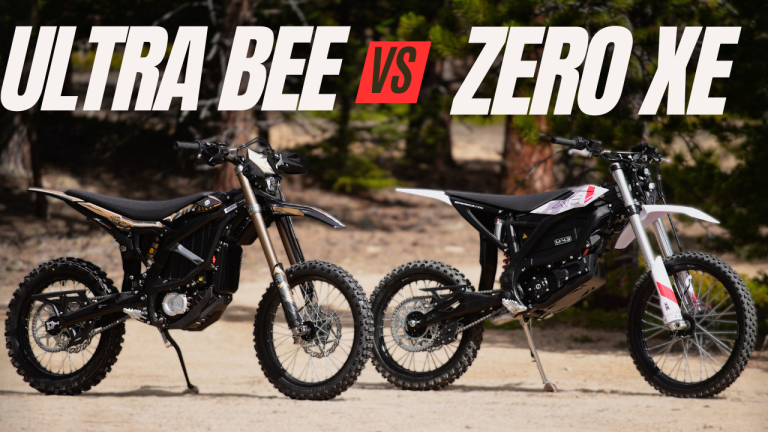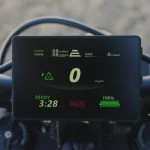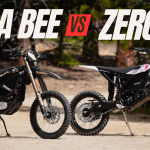The 2025 Surron Ultra Bee and 2026 Zero XE are two of the most compelling mid-weight electric dirt bikes on the market right now (as of June, 2025). Priced similarly and designed specifically for off-road riding, these bikes offer trail-ready performance in compact, approachable packages. But while they appear close on paper, their riding dynamics, design choices, and strengths differ significantly.
Below is a technical breakdown followed by ride impressions to help you decide which bike fits your style.
And don’t forget to check out our new electric dirt bikes for sale!
Chassis & Geometry
Zero XE:
- 21″ front / 18″ rear wheels
- 35.4″ seat height
- 15.5″ foot peg height
- 15.3″ ground clearance
- 34.5″ battery height (from ground to top of pack)
- ~223 lbs (measured)
- Wheelbase: 53.5″ (axle to axle), 54.5″ (contact patch)
- Swingarm length: 20″
Surron Ultra Bee (2025):
- 19″ front / 18″ rear wheels
- 34.6″ seat height
- 14.3″ foot peg height
- ~12″ ground clearance
- 31.3″ battery height (from ground to top of pack)
- ~199 lbs (measured)
- Wheelbase: 54″ (axle to axle), 55.7″ (contact patch)
- Swingarm length: 20.5″
Suspension
Zero XE:
- KKE fork and shock
- 220mm front travel
- 248mm rear travel
- Softer, trail-friendly stock tune
- Vertical rear shock layout
Surron Ultra Bee (2025):
- Updated KKE fork and shock (stiffer than 2024)
- 240mm front and rear travel
- Hydraulic bump stops added
- Holds up higher in the stroke
Powertrain & Transmission
Zero XE:
- 15.5kW peak motor output
- Gearbox transmission
- Quieter and smoother powertrain
- Regen braking
- Traction control
- Reverse mode included
Surron Ultra Bee (2025):
- 21kW boost / 18kW peak in Sport
- Belt drive to jackshaft + chain final
- Turbo mode activated by double-tap
- Stronger mid-range acceleration
- Tunable throttle maps + crawl mode
- Regen braking and Coast Regen
- Traction control
- Reverse mode included
Battery & Range
Zero XE:
- 74V / 58Ah = 4.3kWh
- Estimated range:
- 28+ miles in fast desert terrain
- 30–40+ miles at a mellow pace
- 800W charger (approx. 5 hours to 95%)
- Removable battery
Surron Ultra Bee (2025):
- 74V / 60Ah = 4.4kWh
- Estimated range:
- 20–24 miles in spirited singletrack
- 30–40+ miles cruising
- 10A charger (~4 hours full charge)
- Removable battery
Brakes, Cockpit & Controls
Zero XE:
- 240mm front rotor
- 220mm rear rotor
- Adjustable levers
- Full-color TFT dash
- Cruise control and hill-hold assist
- Left-hand rear brake
Surron Ultra Bee (2025):
- 240mm front and rear rotors
- Adjustable levers
- Updated LCD dash
- Turbo, crawl mode, throttle maps via bar controls
- Left-hand rear brake
Rider Impressions & Trail Feedback
Chassis & Feel:
The Zero XE feels like a larger machine on the trail. It has a more planted, stable presence. The wider bar and taller seat height give it a roomy cockpit up top, but we noted it felt slightly cramped in the lower body due to a higher peg height. Despite its heavier weight, it hides that mass well once moving.
The Surron Ultra Bee, in contrast, feels lighter, more agile, and quicker to respond to inputs. It turns tighter, pivots easier, and accelerates out of corners with more pop. The vertically mounted battery sitting 3” lower than the XE contributes to a more nimble feel through tight, technical terrain.
Suspension Feedback:
Out of the box, the Ultra Bee has a firmer setup that resists bottoming and stays high in the stroke. It’s more confidence-inspiring under braking and through square-edge hits. The stiffer fork makes the front feel more precise.
The Zero XE’s suspension is noticeably plusher and more forgiving. It’s well-suited for flowing trails and smooth OHV terrain but may need different settings to handle faster terrain and small edge chop. With some minor tuning, it became more composed (try running fork tube flush in clamp and 83mm of rear sag).
Power Delivery:
Even though the Zero has less peak power, its throttle response is smoother and more linear. It’s easier to modulate at low speeds and feels quieter and more refined, likely in part due to the gearbox design.
The Ultra Bee hits harder. The lighter weight combined with higher power makes it feel more responsive and eager. However, the throttle can feel jerky, especially in Sport or Boost, even with the throttle set to F1, it’s softest throttle setting. The belt drive is quiet until it gets dirty or wet, where it may squeal or slip under load.
Handling & Turning:
The Ultra Bee turns sharper and feels easier to maneuver in tight singletrack or technical sections. Riders noted it was easier to recover from line mistakes or make quick directional changes.
The XE tracked straighter and more predictably in smoother high-speed terrain. Its 21” front wheel gives it an edge in rough terrain, offering better roll-over capability. However, its turning radius was more limited, and it required more effort in tight, pivot-turn scenarios.
Braking Feel:
Both bikes feature similar brakes. The Ultra has slightly more bite likely thanks to its lighter weight and smaller wheels. Both bike’s brakes feel good out of the box, though we would recommend upgrading brake pads for more stopping power. The levers on the Ultra were easier to adjust closer to the bar. The XE levers are also adjustable, but we wish they could be adjusted closer to the bar.
Comfort & Ergonomics:
The XE cockpit felt more refined overall. The TFT dash is clearer, the buttons are well laid out, and the bike feels like a finished product. The Ultra Bee’s updated dash works fine, but the interface feels more utilitarian.
Some taller riders preferred the XE’s reach and bar position. Others noted the Ultra Bee’s narrower cockpit made it easier to throw around, and aftermarket risers or bar swaps quickly solve ergonomic preferences on both bikes.
Range Performance:
In real-world use, both bikes were within 3–5% of each other. The Zero seemed to hold power a bit longer before limiting output, while the Ultra Bee stayed strong down to around 10% before tapering off. Riders reported similar usable ride time (~2–3 hours of normal trail use).
Final Thoughts
If you want a more agile, mod-friendly platform that hits hard and feels playful, the Ultra Bee is a great pick. It’s built to be tuned, tossed around, and adapted to your riding style.
If you’re a larger rider or prefer a stable, polished bike that’s ready to go out of the box, the Zero XE offers a smooth, refined trail experience with solid components and great balance.
Both are strong contenders in the mid-weight electric space. Choose based on how you ride — not just what’s on the spec sheet.









